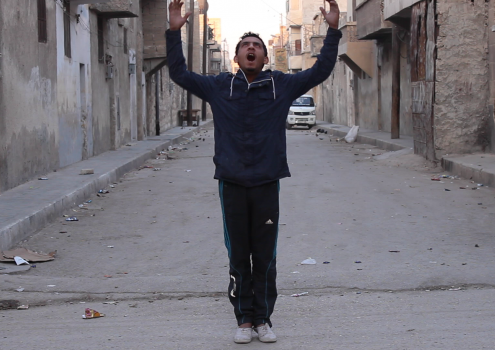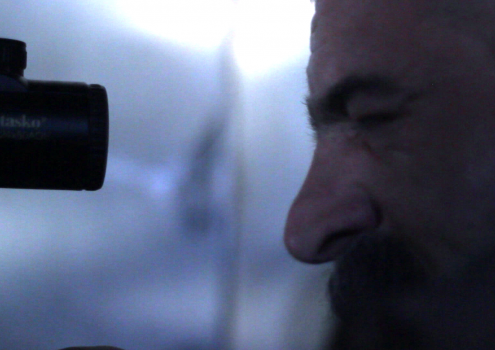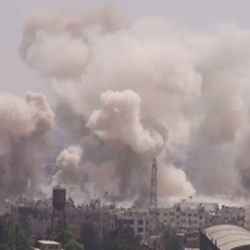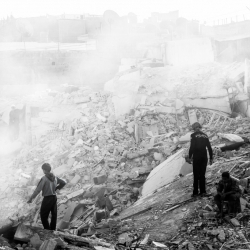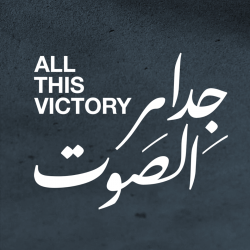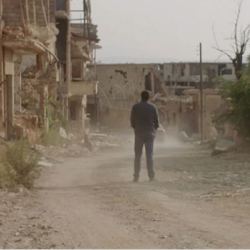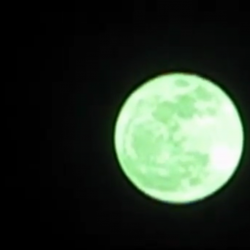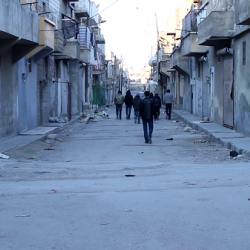17/06/2015
Author: Orwa Al Mokdad
Photographer: Orwa Al Mokdad
The sky fell. The rusty fragments of metal rent air thick with the reek of bodies burnt by artillery fire and napalm. The buildings, warring with the thickets of lance-like rifles, groaned in the pitch-black night, alive with the endless screams of people who could find no way to live save tearing one another to pieces.
The sky dropped earthwards with the falling barrel, the distance between it and the machine guns and the gore-drenched bodies beneath less than the distance that divides the 50mm lens in the bag from the 55mm lens on the camera. The barrel takes seven seconds to fall; I need ten seconds to change the lens—to change it, because the narrow lens with the wide aperture lets more light in, gorges on the details of the dreamy faces, dead to their survival instinct.
What if the barrel fell on us? What if the camera survived, to roam through hell? What if the skin sloughed off the delicate, gauzy form within us, for our feelings to emerge visible and tangible, freighted with hurt and pain, and the body’s molecules slipped through the beams of light into the darkened room, were transmitted to the flat-screen and the eye that lazily observes it all.
As I stared at the shuddering conflagration, I asked myself what was preventing me taking a machine gun and heading for the nearest firefight, just four hundred meters away. To want that would be a death wish, no doubt about it: the desire to end one’s life quickly, and in a way that had some meaning. A dramatic end, befitting the conclusion of a long, long movie that began long ago and is even now not done. Where does the film begin and life end?
Carrying a gun wasn’t a problem in and of itself. The machine gun I had must have dated back to the Second World War.“The Samopal”, a friend gave it to me after the ISIS assassinated and kidnapped a number of our acquaintances and we’d been spared by sheer chance. None of us wanted to die with our wrists slit. I concealed the camera back then and slung it over my skinny shoulder. My hand didn’t tremble—this was just the first time, after all—but my eyes shook, almost cinematically, transforming the city into a filming location, the scene of constant experiments in emotions and forms of death.
“The Samopal” wasn’t out of place in these surroundings, amid flame licking from one side of the burning hulk and the cold breeze that sprung from every direction and painted the faces red, dying them the color of blood. In this war-scape, the machine gun was in its element. The odd one out was the camera. The little device was dramatically flung down beside the gun: barrel pointing at my face, lens staring out into the void.
I turned the metal barrel towards the wall and capped the lens which was recording the passage of a time that concerned no one but those hunkered in this darkened room. Crumbling walls in a poor district. The ISIS forces enter. Once more, I open the camera. I switch my gaze between the screen and the frightened faces. The red blends with the orange thrown out by the lamp. Blades slip softly into skin. Eyelids dip in fetching sorrow. Lashes flicker in a start of distaste and hoarse screaming. Arms sway out of the frame then slump back in. Body parts fly. Inside the frame there is no sound, only the squeak of blades scraping against fragile bones. Lips slip from teeth in a smile of thanks and gratitude to the god of the guillotine. The blackness swirls into the crimson to form a quicksilver void. Blood spurts on the lens. The spattering droplets hide the features that the blades are starting to rearrange. Blood flows to my feet. The blackness falls about my neck and drowns the lens. The shot is lost to view.
Warring emotions as we dream up scenes that might occur at any moment. Fear shot through with anxiety for the young friends in whose house I’m staying. It’s no longer frightening to imagine death by mortar shell or barrel bomb: that’s something I’ve experienced many times and so have come to expect. But to imagine them dying in this brutal fashion is too terrifying to cope with.
I started to think, as the scene played over and over in my head: Was it in some sense cinematic? How does one create something cinematic, different to the drily documentary—assuming that what is cinematic is aesthetically superior to straight reportage? The author looks for protagonists: she needs a story of a “hero” or “victim”, a particularly thorny problem in contexts thrown up by the revolution, for the hero no longer matters, and the drama does not hinge on individual deeds but on collective action. How then to make a film that avoids the trap of “story” or “hero”, one many films from the Syrian revolution have fallen into? How is it possible to make a film about life in which hero and director step aside? To produce a dramatic tale that glorifies life when faced with the glorification of excessive violence, which the ISIS propagates in its productions? To break this rule I had previously attempted to depict the “Shaar” Market, surrounded by frontlines and ISIS-controlled checkpoints, in one of the most dangerous areas of the city targeted by barrel bombs, as a protagonist in its own right. Though there was a compelling, subjective dramatic center to this tale, it paled in comparison to the bustle of daily life and the cheerful smiles of the inhabitants in the midst of all this surrealism. Faced with the literature of film festivals and the theorizing of directors on the nature of the “cinematic”, the problem seemed truly intractable.
Thinking about a feature-length documentary that would try to combine the cinematic with elements which would subvert the conventions of individual-centered drama, I came across another difficulty: films are the product of preparation, but how could you set up a scene in the face of death? A cinematic sense is created by a pre-existing and selective vision, which reproduces reality through the processes of preparation, filming, and editing. Ultimately, the cinematic is that which is subordinated to the aesthetic. How can the aesthetically beautiful coexist with death?
Filming and documenting is as dangerous as” The Samopal” that hangs from my shoulder. This particular gun is known as “the trickster” due to its lack of a safety-catch: it’s killed many of the fighters who carry it. The camera is like this gun. When you depress the red button it starts to record reality, a surface reality uncoupled from the complex feelings of fear the lens can’t capture, and it’s impossible to fiddle around with angle and perspective when you’re face to face with death. Subsequently, the images are subject to cutting and recoupling in the editing room. As Russian director Pudovkin said, the art of cinema does not stem from the desire to create a true depiction of reality, but rather, to transform reality into cinema.
Scenes from “Battleship Potemkin” came to mind, especially those of the massacre on the Odessa Steps. Eisenstein fashioned a beautiful scene out of a mass killing committed by the Czar’s soldiers. On film, this event was recreated to become aesthetic, thus fitting in with the other scenes and the cinematic medium itself. Despite the length of the scene, which lasts twice as long as the event itself, it does not highlight the mechanics of the killing and the terror of the incident but rather the aesthetics of perfectly crafted cinema. The moment in which you decide to press the red button, faced with the overwhelming contradictions you are documenting, resembles the moment in which you casually flick the gun’s trigger, assuming that there’s a safety-catch. This moment is nothing to do with the physical and mental destruction around you, it is an act of creation: a bullet fired at the truth you are recording, a truth that appears to be missing from many such films, sacrificed in favor of the story and human drama.
Memory, in the way it has operated to date, also resembles the process by which editing reshapes reality. This is why cinema calls for a physical and temporal distance from the historical event it depicts, in order to reimagine it. Critics like to think that this shows maturity in dealing with reality, but I am rethinking the question of the nature of art (in general) and of cinema (in particular). What is required of film? Is it a functional medium or an aesthetic one? Certainly, cinema that is both, is more vibrant, but it is also an engagement with our memories and the way we think. It jettisons many details and it is selective. Forgetfulness is one of the things that allows our lives to go on as they are. This is why cinematic production ignores many details and why the director—whose job it is to efface many details, as well—maintains a distance from the event.
Just as the camera does,“the Samopal” has accompanied me on my endless back and forth between the ISIS checkpoints that fill the city. It felt extraordinarily incongruous, and I wished there was some way to document those moments that saw me travelling from the modest home towards a long front line controlled by the regime, through their terrifying checkpoints, beneath a sky pregnant with barrel bombs and shells, on my shoulder a bag in which I’d placed the little camcorder, and on the other shoulder slung a submachine gun left over from the Second World War. My features, which made me look like a refugee, coupled with my thick southern accent, were like a secret password that saw me sail through the checkpoints.
The greatest contradiction thrown up by my thinking was the state photographers find themselves in: constantly observing and never part of the action. This, it appears, is precisely what stimulates the viewer, for the photographer is an “outside” eye, not caught up in events, while the viewer, though maybe biased to one side or the other, is similarly coming from the outside: witnessing events as a passer-by. If cinema moves us to sympathy through its aesthetic beauty, how can we engage the casual viewer or critic in an event that has in essence been formulated as neutral? When I set the camera up on the corner of The Jasmin plant beside a door ripped to shreds by a falling barrel bomb, in the presence of three young men whose moral compasses and will to resist has been affected to differing degrees by the violence they face, how can the dense passage of time flow through to the flat-screen, along with the barrel’s roar shattering the air and turning it to terrifying flame?
The World War Two machine gun lies on the ground beside my frail body. Together, this hunk of metal and me quiver as the regime tanks advance, just five hundred yards meters away. The dawn rises with the soldiers, and the war, with the tank tracks bequeathed to it by the World Wars that came before it, rises too. These wars were documented by cameras in the sky and on the ground. Back then, many directors and photographers wielded their cameras in the hope that they could stop the fighting, that the war would become a lesson from which humanity could learn. But here it is, the same old scene recurring, as though planned in advance: a camera, a machine gun, and victims, the ordnance even more destructive, and audience that derives a kind of enjoyment from the sight of excessive violence. The question that always suggests itself to me in such harsh moments is what should I record and whom? What in the frame is significant? What should I select and what must I discard to suit the viewers sitting at home watching their TV series and movies? What is significant to the critic, evaluating the images based on the tempo of the action, its fluency, and the directorial vision?
Films didn’t alter the nature of what happens, but the act of watching continued. What matters, therefore, is what is in the frame and not what exists outside it, in wider reality. For we are already prepared to see what the director wishes us to see within the frame, as people watching from “outside”. How then can one make a film that completely changes this point of view? This is a complex question, not necessarily just to do with cinema, since cinema has never been separate from the other arts but is rather the most representative and realistic of them. Looked at a different way, it is the strongest proof of our bloodthirstiness and enjoyment of violence.



